
Fédération Internationale de Philatélie
Last update: 06-Feb-2019
AEROPHILATELY EXHIBITING
SUGGESTIONS ON HOW TO BEGIN Part I
So, you wish to exhibit in aerophilately. We will discuss Subclass (A) firstly as it is with regards the development of airmail. This could put you in one of two categories.
1. New Exhibitor and has collector that has built up a number of airmail covers and /or airmail stamps and you now wish to exhibit your collection as an exhibit.
2, Existing exhibitor who now would also like to diversify and exhibit in aerophilately and is not sure exactly how to begin and build up his collection to include suitable material for an aerophilately exhibit. This would vary from person to person
We will initially discuss them separately, as at this stage they may not have sufficient material for an exhibit.
1. NEW EXHIBITOR
The first thing that we need to ascertain is what the exhibitor has in his collection and the reason for his collecting this material. When this has been ascertained e.g. the new exhibitor states that he has been collecting Graf Zeppelin mail to, from and through Brazil, as he was born there. He says that he only collects mail carried on this Zeppelin LZ 127 on flights via Brazil.
At present he knows that he does not have an example of airmail carried on all of these flights as he is not absolutely sure that mail from some countries exist . Below is a cover from his collection carried on the first flight from Brazil in 1931. It was carried as far as Friedrichschafen then by DLH to Prague and then delivered by pneumatic mail within Prague.

 Reverse reduced to 75%
Reverse reduced to 75%
Another example could be as follows; A New Exhibitor had been collecting airmail to and from Belgian Congo for many years and has over 100 covers from Belgian Congo from all over the world such as the one shown below.

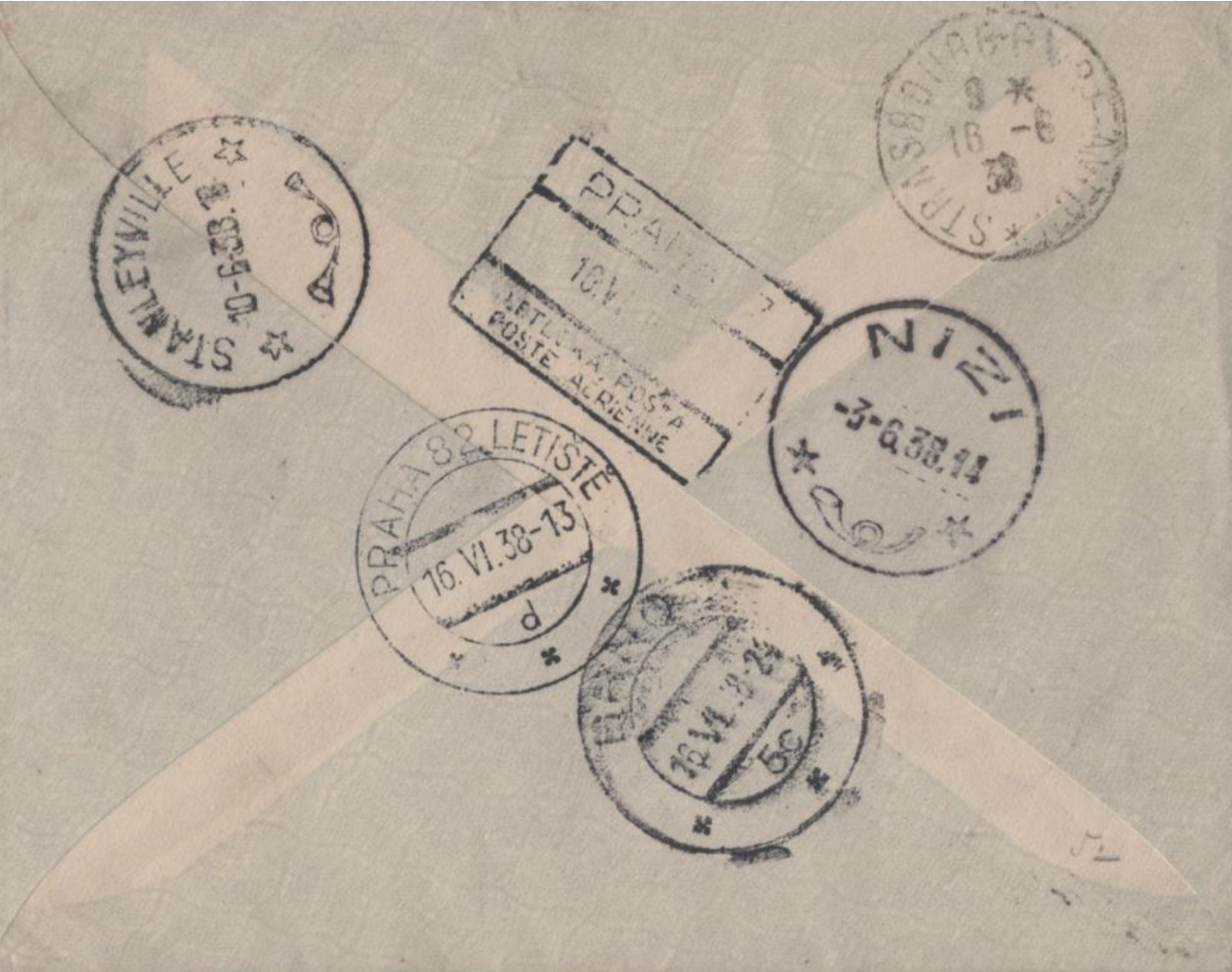 Reverse
reduced to 75%
Reverse
reduced to 75%
These are just two examples of collections that potential exhibitors have in their possession that are waiting to be exhibited. The reverse is shown at a reduced size, as this is what is necessary in an exhibit, so we will start by showing this rule before we go any further.
2. EXISTING EXHIBITOR
Here I will give three examples of existing exhibitors who have exhibited in three different classes; Postal Stationery, Traditional and Postal History and wish to continue in the same country with aerophilately exhibits.
Example 1: Czechoslovakia Postal Cards Exhibit
This Exhibitor is a qualified exhibitor of Czechoslovakia Postal Cards and has noticed that he has a large collection of uprated Postal Cards sent by airmail and on this basis, would like to exhibit in aerophilately. He realizes that he will need to obtain many other covers to complete his exhibit but since postal cards uprated for airmail, are difficult to obtain, he feels that this is a start to obtain sufficient material to create an aerophilately exhibit. Many exhibitors of aerophilately do not show enough variety of the types of material carried and in some instances, the postcards are much harder to find than the covers.

Though this card is overpaid by 80h it clearly shows that it was flown to Austria (rate 70h plus 50h airmail) while the one below is correct at 2k 40h plus 1k 50h airmail rate to Sweden

Example 2: Kenya Uganda and Tanganyika Exhibit
This exhibitor has discovered that he has many items left over, that were not the best available to put into his traditional exhibit with many multi franked covers which would be a good starting point for an aerophilately exhibit.

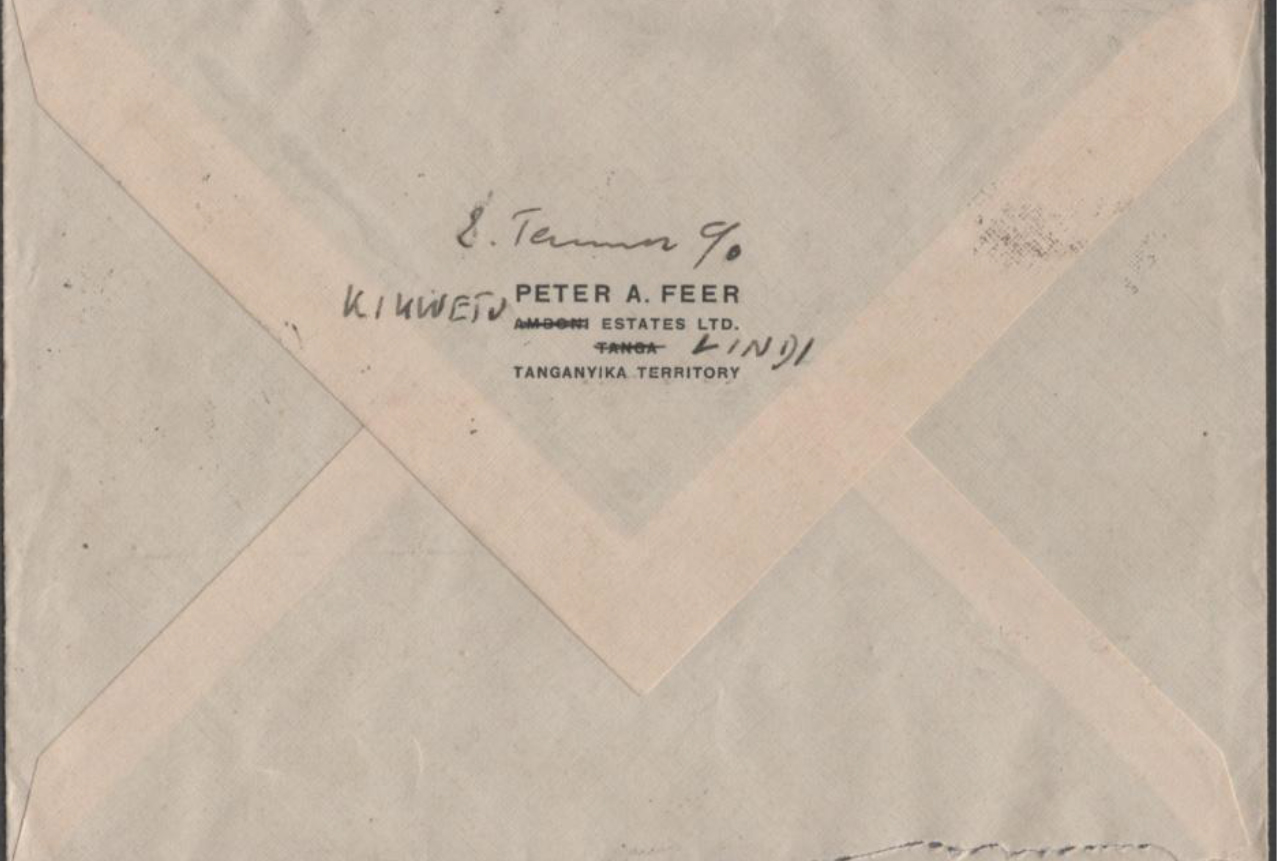
The 1937 airmail rate was 75c per 1/2 ounce to Switzerland with no backstamps and therefore should not be shown in an exhibit, is shown here to just emphasise that point.
Airmail Cover 1945 to Belgian Congo
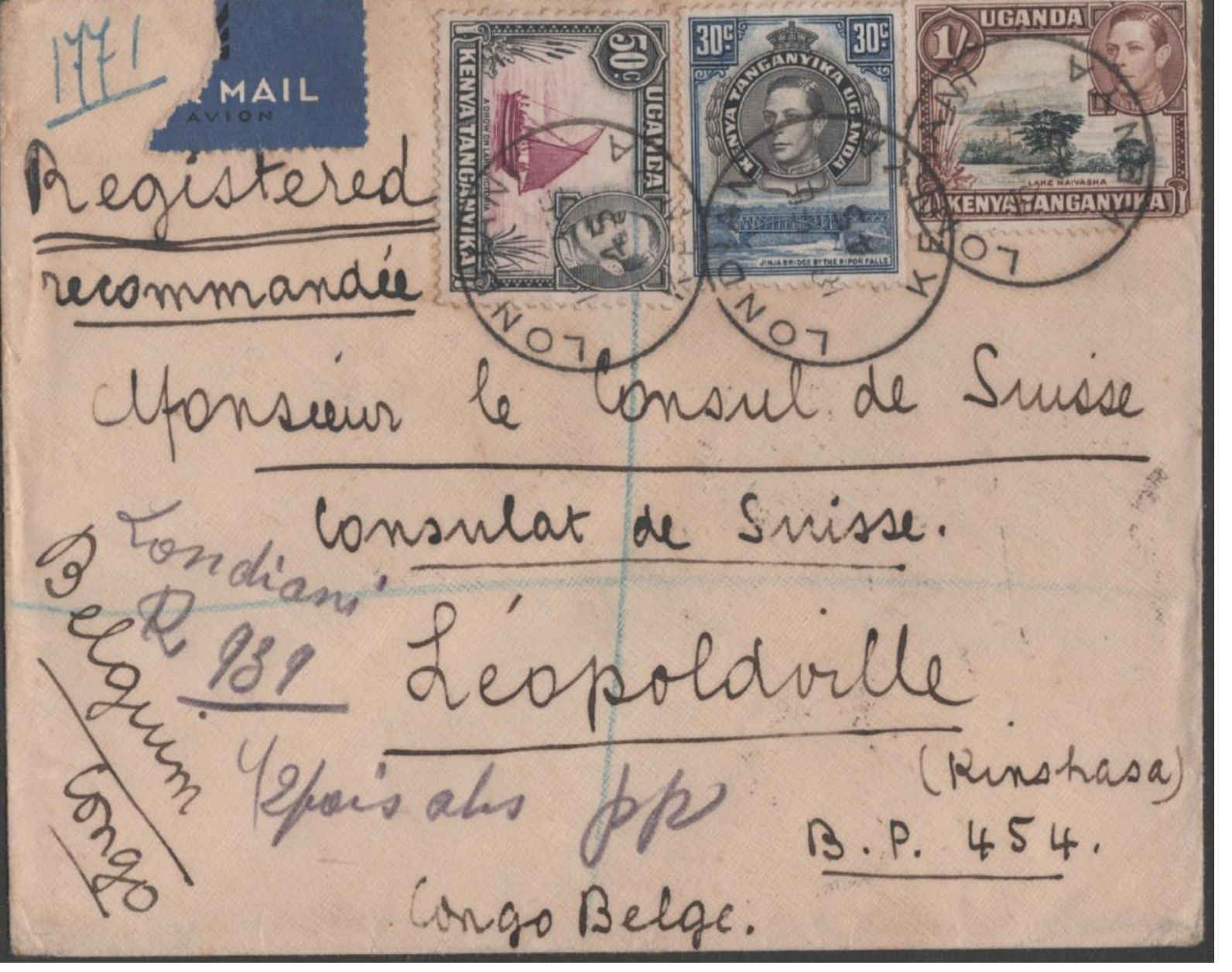
Backstamps clearly show the route that the cover has taken to its destination at 1s 50c per 1/2 oz plus 30c for registration.

Example 3: Nyasaland Exhibit
The exhibitor again has discovered that he has many airmail items left over for his aerophilately exhibit and makes a good basis to begin acquiring additional items to exhibit
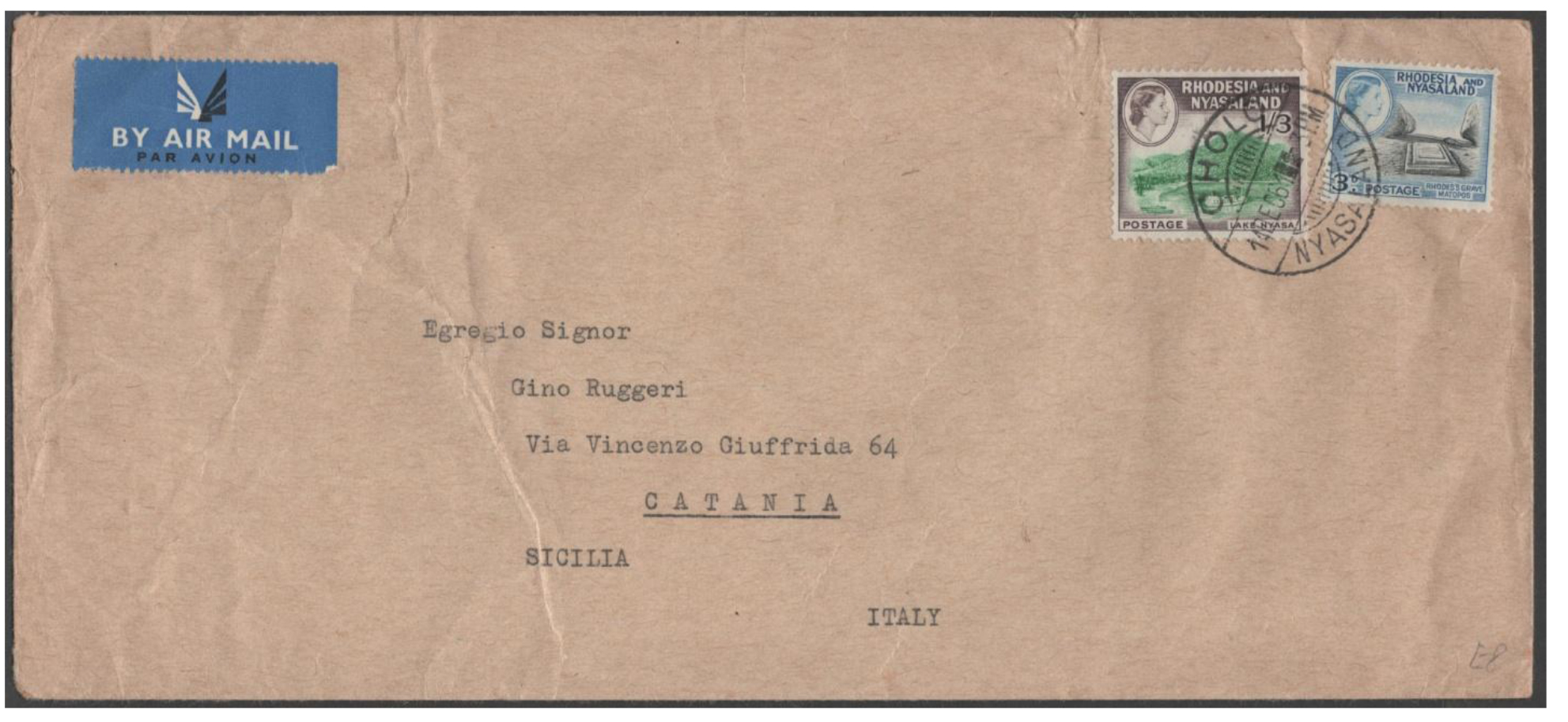
Below is the reverse of the cover showing only the destination which is at the 1s 6d rate to Italy. Again, in this instance, it is only shown for educational purpose and should not be shown in an exhibit. Stating it is backstamped on arrival is sufficient.
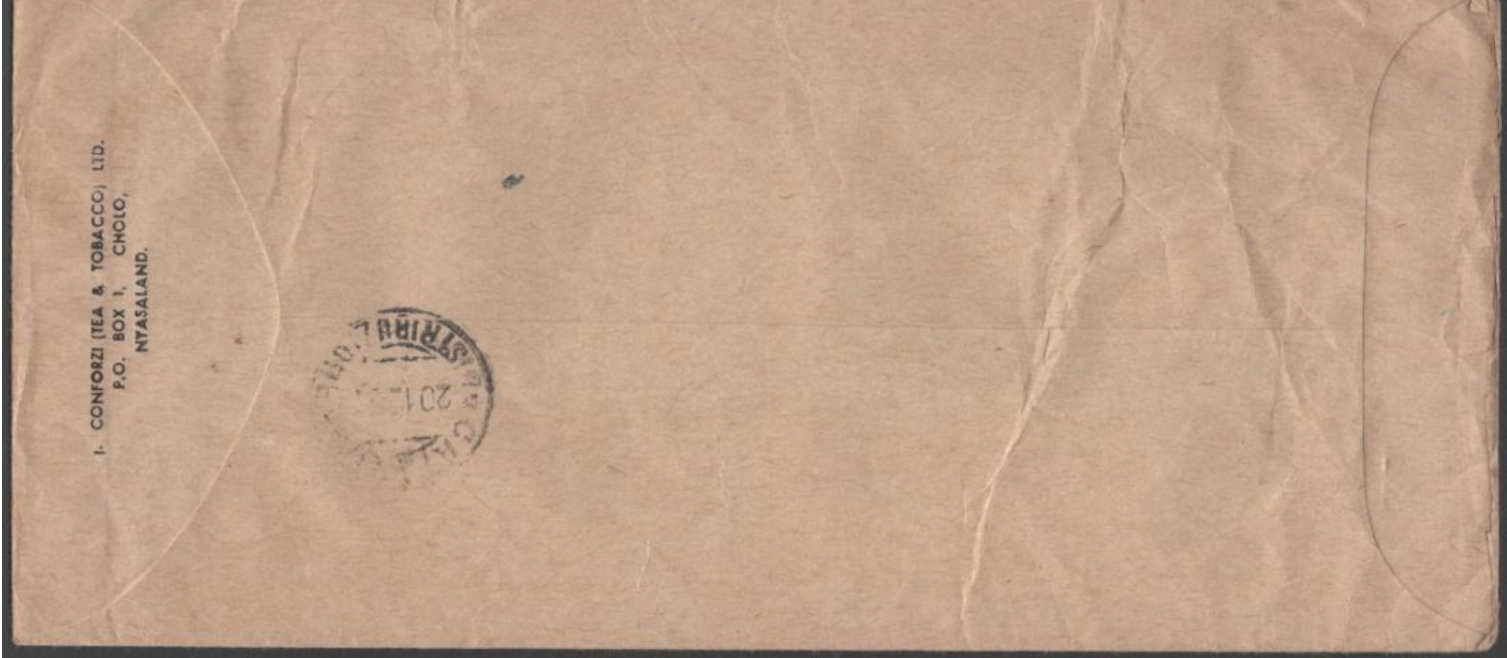 Reverse
reduced to 75%
Reverse
reduced to 75%
Now that we have set up examples of 5 potential exhibits in aerophilately subclass (A)
Before we go into more details on the rules of exhibiting as a whole for aerophilately, now that I have your attention, I wish to explain why people like to exhibit.
The desire to show other people your collection
Wanting to be part of what many other collectors are doing
Having the opportunity to obtain assistance from other collectors and judges on how you can improve your exhibit
Imposing the discipline on yourself to organise your collection
Gaining an award and being able to improve your exhibit to enter at National and International levels
Increasing your enjoyment in the wonderful hobby
I will now give the exhibits their Titles in the order 1 to 5 so we can go through potential the exhibits and discuss the rules for exhibiting aerophilately and how the judges should interpret the SREVs (rules) and Guidelines.
1. Brazil the Graf Zeppelin LZ 127 Connection
2. Development of Belgian Congo Airmails
3. Czechoslovakia Airmails 1918 to 1940
4. Kenya Uganda and Tanganyika Airmails
5. Nyasaland Airmails
JUDGING THE AEROPHILATELY SUBCLASS (A)
· 1. An Aerophilately Exhibit in Subclass (a)
· 2. Defining Aerophilately in Subclass (a)
· 3. Composition of the exhibit
· 4. Arrangement of the exhibit
1. AN AEROPHILATELIC EXHIBIT IN SUBCLASS (A)
· An Aerophilatelic exhibit is composed essentially of postal documents transmitted by Air
· The word “postal” is to be interpreted to cover all transportation of mail by air. If this is not done, then we would be unable to include such things in exhibits as the Vin Fiz flown cards, Barrier Island Pigeon Post and various private Pioneer material.
· “Transmitted by air” must include mail that was prepared but could not be due to such things as poor weather of mechanical problems.
2. DEFINING AEROPHILATELY SUBCLASS (A)
· Aerophilately represents a study of the development of the air mail services and a collection of documents pertaining to such development.
· To be judged as Aerophilately the covers must be organised to show the development of airmail services. In other words, there must be a recognised aerophilatelic theme.
3. COMPOSITION OF THE EXHIBIT SUBCLASS (A)
· Postal documents despatched by air
· All types of postal and other marks, vignettes and labels relating to aerial transport
· Items connected with a particular means of aerial transport, not conveyed through a postal service but deemed important to the development of airmail.
· Leaflets, messages and newspapers dropped from the air, as a way of normal postal delivery or on the occasion of postal services interrupted by unforeseen events
· Mail recovered from aircraft accidents and incidents
Aerophilatelic exhibits may include ancillary items, such as maps, photographs, timetables and the like as long as they are considered vital to illustrate, and draw attention to a particular point or situation. They should not overpower the other material and accompanying text on display. (Article 3.3)
Note: For every ancillary item that is included there is at least one other (possibly more relevant) item that cannot be shown within the exhibit.
4. ARRANGEMENT OF THE EXHIBIT
The arrangement of an aerophilatelic exhibit derives from its structure following a basic pattern.
· Chronological
· Geographical
· Means of Transport:
1. Pigeon
2. Lighter than air
3. Heavier than air
4. Flying Boat
5. Rocket
The plan or concept of the exhibit shall be clearly laid out in an introductory statement
We now have an idea how to set out an exhibit in aerophilately sub-class (A). Of the 5 exhibits discussed previously by their title No 1 would be by Means of Transport (Lighter than air) with the other four being Geographical. Most of them would be done chronologically even without changing the title and as number 3 already has a period given this gives and starting and ending date. The other three do not require and starting and ending date but they could have one as the assumption would be that they start from when airmail was first introduced and end when the country changed its name on Independence. If you did not wish to show the airmail for the full existence of the country, then you can always stipulate the dates that the exhibit covers.
The other thing that you need to decide is what your exhibit will contain. By that I mean, are you going to have outwards mail only or inwards, outwards and through airmails. This should be determined when you start to build your collection and must clearly be shown when you create your introductory page.
We will discuss this more in Part II of this AEROPHILATELY EXHIBITING – SUGGESTIONS ON HOW TO BEGIN.
Copyright © 2004-2019 by the
FIP Commission for Aerophilately